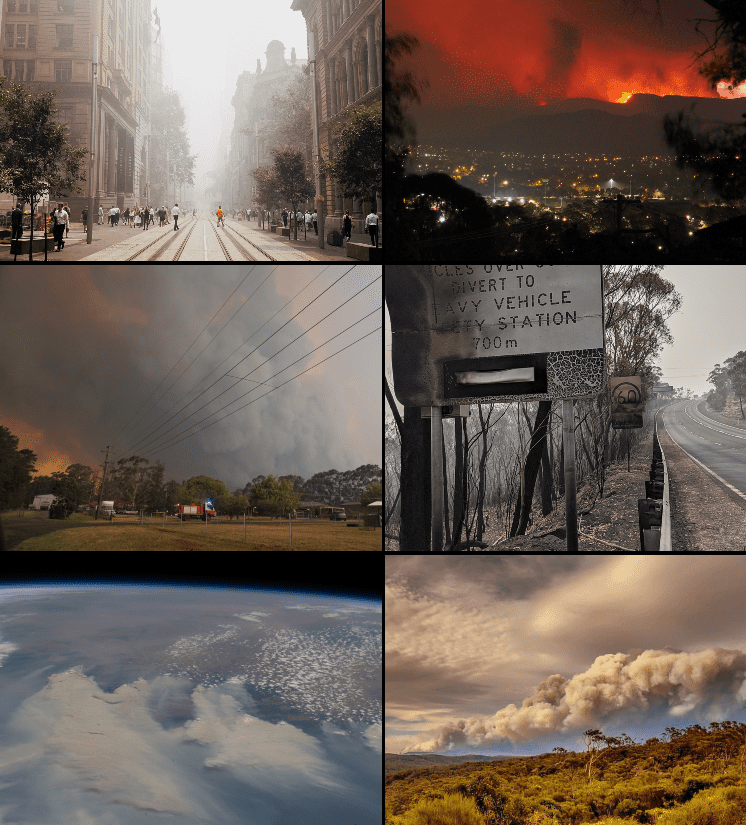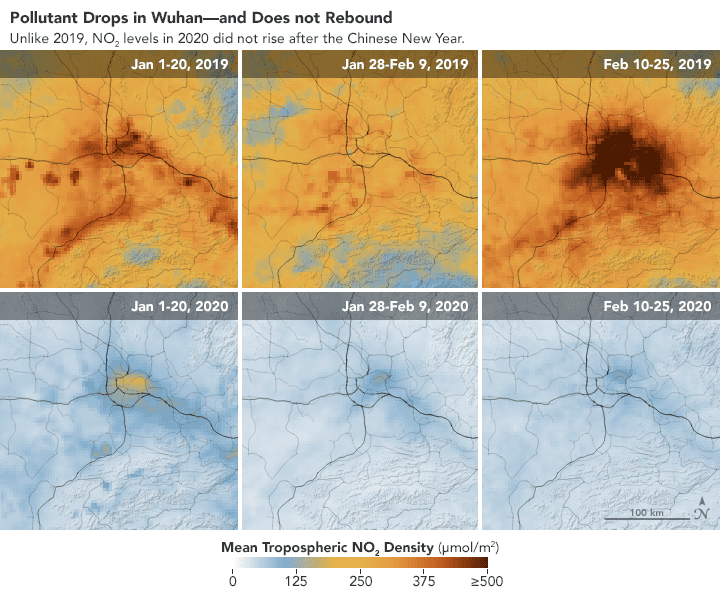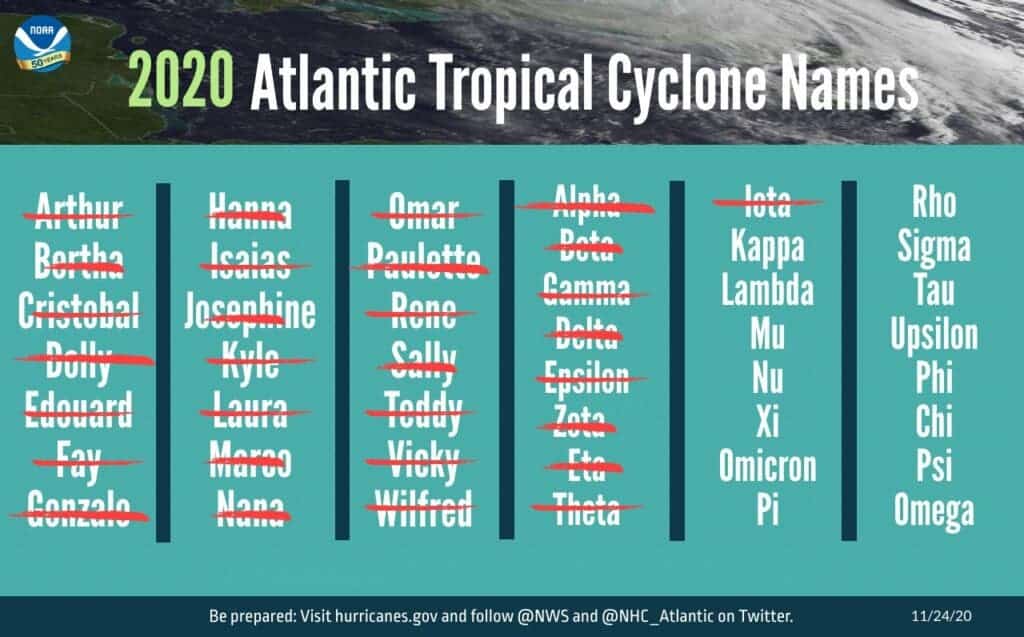Despite the coronavirus pandemic overtaking most of the 2020 agenda, this was also a big year for environmental, climate, and energy news. There were some positive developments (such as the falling cost of renewable energy and the surge of solar and wind power) but also a lot of bad news, especially in regards to greenhouse gas emissions and plastic pollution.
We selected what we consider some of the environmental highlights of the year and compiled a 2020 list. With 2021 around the corner, we hope this review will help to reflect on what has happened over the year and consider how to take to better take care of the planet.
2020 set to be one of the warmest years on record

The World Meteorological Organization (WMO) published in December its State of the Climate Report, which showed that 2020 is on track to be one of the three warmest ever recorded as emissions continue to rise, despite the pandemic which kept us more time inside. The average global temperature is set to reach about 1.2º above pre-industrial levels.
To make matters even worse, this year has been unusually hot despite the cooling effect of La Niña, the climate phenomenon associated with below-normal sea surface temperatures in the Pacific Ocean with global implications. Its impact has been more than offset by heat trapped in the atmosphere by greenhouse gasses.
Arctic sea ice reached its second-lowest level in the 42-year-old satellite record. Arctic sea ice for July and October 2020 Almost 10 million people were displaced, largely due to hydro-meteorological hazards and disasters, mainly in South and South-east Asia and the Horn of Africa. Two ice caps in Nunavut, Canada have disappeared completely, confirming predictions of a study published in 2017 that they would melt completely within five years.
Deforestation record in Brazil
Deforestation in the Amazon rainforest in Brazil reached a 12-year high. A total of 4,281 square miles (11,088 square kilometers) of the forest were destroyed in the 12 months to August 2020, according to Brazil’s space agency PRODES program, which monitors deforestation.

While most of the Amazon lies in Brazil, the rainforest affects all of us. Rainforests like the Amazon play a key role in controlling climate as they absorb carbon, a greenhouse gas, from the atmosphere. Nevertheless, when they die or burn, trees release carbon back into the environment.
Brazilian President Jair Bolsonaro came to power in 2019 promoting an agenda based on more extractive activities in the Amazon. He even asked Congress to change environmental protection laws and cut the budget and the staff of the federal environmental protection agency IBAMA. Many high-ranking politicians, including French President Emmanuel Macron and president-elect Joe Biden have criticized Brazil for not doing enough to protect the forest.
Australian wildfires
The 2019-2020 Australian bushfire season started in June 2019. Several uncontrolled fires were reported. Amplified by drought, the fires continued to spread, and by January 2020, fires had burnt an estimated 18.6 million hectares (46 million acres). For comparison, the California wildfires burnt 800,000 hectares (2,000,000 acres) and the 2019 Amazon rainforest wildfires burnt 900,000 hectares (2,200,000 acres) of land.

It was the worst bushfire season on record and the “worst wildlife disaster in modern history,” according to a report by the World Wild Fund for Nature (WWF), with three billion animals affected. This includes 143 million mammals, 2.46 billion reptiles, 180 million birds, and 51 million frogs which were harmed.
Authorities and firemen (both professional and volunteers) put up a tremendous effort to limit the fire, but all they could do was limit the scale of the damage. Much of the affected areas had been in drought for three years and the lack of water transformed green plants into perfect fuel for the fire, helping spread the damage. As Australian researchers had predicted for over a decade, higher temperatures are starting to take a toll.
The world’s largest offshore wind farm
The UK, already the world’s leader in offshore wind, is getting ready to start construction of what will be the world’s biggest offshore wind park, Dogger Bank. The British utility company SSE and the Norwegian energy firm Equinor agreed to invest $8 billion in the project, which will be used to build the first two phases. The wind farm is being developed in three phases and each phase will have an installed generation capacity of up to 1.2 gigawatts (GW).
The construction of the first two phases, with 2.4 GW capacity, will be financed by a group of 29 banks and three credit export agencies. They will be built at the same time starting in 2021 to maximize the synergies due to their geographical proximity and make use of common technology and contractors. Offshore wind in the UK now powers the equivalent of 4.5 million homes per year and in many areas, and wind is now the lowest cost option for new power in the UK.
US set to rejoin the Paris Agreement under Biden
Democratic candidate Joe Biden won the presidential elections in the United States and he’s already lining up big changes on climate change as soon as he takes office on 20 January. The biggest change will be rejoining the Paris Agreement on climate change, following President Donald Trump’s decision to leave the pact.
Biden has promised measures to put the US will on track for net-zero emissions by the middle of the century. This would have a big effect on meeting the Paris Agreement’s goals. An analysis by Climate Action Tracker, a non-profit organization, said Biden’s climate plan could put the Paris’ goals “within striking distance”.
Biden vowed to eliminate carbon emissions from the electric sector by 2035 and spend $2 trillion on investments ranging from weatherizing homes to developing a nationwide network of charging stations for electric vehicles. If he can’t implement it through Senate, he’ll have to rely on executive orders to advance his agenda.
Air pollution drops with the pandemic

The lockdown measures implemented across the world at the start of the pandemic improved air quality and averted thousands of deaths in regions with severe air pollution, according to several studies. Scientists are increasingly calling for more ambitious policies to achieve larger air quality improvements in the future.
A team of scientists at the University of Notre Dame found that particulate matter concentrations in China and parts of Europe dropped by 29.7% and 17.1% respectively during the lockdown. They measured air quality between February and March in China and February and May in Europe, when stay-at-home orders were in place. The European Environmental Agency (EEA) published the report “COVID-19 and Europe’s environment” and showed how concentrations of NO2 — a pollutant mainly emitted by road transport — fell sharply in many European countries. Reductions variated between countries, depending on how severe was the lockdown.
Particulate matter, small airborne particles, comes from combustion-related sources such as industrial emissions, transportation, wildfires, and chemical reactions of pollutants in the atmosphere. This has turned air pollution into the leading environmental cause of death, according to the World Health Organization.
Record number of storms
The 2020 hurricane season broke several records, especially regarding the number of storms in the tropical Atlantic and the Caribbean Sea.
In May, the Climate Prediction Center of the National Oceanic and Atmospheric Administration (NOAA) forecasted that 2020 would be an above-average hurricane season. The main reason for this is the above normal sea surface (SST) in tropical Atlantic and the Caribbean Sea and stronger West African monsoon, key conditions for the formation of tropical cyclones. But few would predict what ended up happening.

To the surprise of everyone, it wasn’t long before we reached a point where there were no more new names for storms. Tropical Storm Arthur was the first to form on May 16th and lasted until May 19th. Eight days later another tropical storm was formed and the list continued until the last name, Wilfred, on September 13th. It’s not just the number of storms, its intensity was also pretty scary. During this season, there were four simultaneous events, at least 2 storms happening at the same time. Laura and Marco, both hurricanes, started together and continued staying active almost at the same time. Laura was the strongest storm to hit Louisiana in the US.
Over 80% of 2020’s new energy is renewable
Led by solar power, renewable energy could account for 80% of the growth in electricity generation over the next decade, according to a report by the International Energy Agency (IEA). It’s now consistently cheaper to generate electricity from the sun than by burning coal or natural gas in most countries, IEA said.
The IEA, an intergovernmental organization, said electricity costs from large-scale solar photovoltaic installations have fallen from roughly 38 cents per kilowatt-hour in 2010, to a global average of 6.8 cents per kilowatt-hour last year. This means solar could become “the new king” of the world’s electricity markets, IEA head Fatih Birol said.
At the same time, a report by the energy consultancy Ember found that wind and solar doubled their share of global electricity generation since the Paris Climate Agreement was signed in 2015, reaching almost 10% in the first half of the year.
Coral reefs take a big hit
Australia’s Great Barrier Reef has lost more than half of its coral population in the last three decades, according to a new study, with climate change being the main driver of this loss. The researchers found that all types of coral had suffered a decline here, in the world’s largest reef system.
The year 2020 was not kind to the reefs. A third mass coral bleaching event in five years was recorded at the Great Barrier Reef, showing that for the first time, all the major regions in the Barrier Reef experienced severe bleaching. This is largely caused by global warming and ocean acidification — which is also a result of carbon dioxide being pumped into the atmosphere and then absorbed by the oceans.
Coral reefs are some of the most vibrant marine ecosystems on the planet. They are called the rainforests of the sea, as between a quarter and one-third of all marine species rely on them at some point in their life cycle. Fishes and other organisms’ shelter, find food and reproduce near them. The Great Barrier Reef covers nearly 133,000 square miles and is home to more than 1,500 species of fish, 411 species of hard corals, and 4,000 types of mollusk.
Carbon neutrality targets
Around the world, countries have started committing to carbon neutrality targets by 2050 or 2060, a vital step to addressing global warming. Chinese President Xi Jinping announced in September that China will aim to reach peak emissions before 2030 and then carbon neutrality by 2060. The country is the world’s largest source of carbon dioxide, accountable for about 28% of the global emissions. Emissions in China rose in 2018 and 2019.
South Korea’s president, Moon Jae-in, declared in October that the country will go carbon neutral by 2050. He vowed to end its dependence on coal and replace it with renewables as part of its Green New Deal, a multibillion-dollar plan to invest in green infrastructure, clean energy, and electric vehicles.
Several countries have already mandated carbon neutrality by law. France, Germany, Hungary, Denmark, New Zealand, Scotland, the UK, and Sweden have legally committed to carbon neutrality by 2050, while several other countries (including South Africa, Belgium, Norway, and Portugal) have adopted policies to do so.

Microplastics, microplastics everywhere
The world’s seafloor is riddled with 14 million tons of microplastics, broken down from the masses of rubbish entering the oceans every year, according to a study. It’s the first global estimate of sea-floor microplastics and the amount registered is 25 times greater than that shown by previous localized studies.
Plastic pollution in the world’s oceans is an internationally recognized environmental problem. Millions of tons of plastic enter marine ecosystems every year, and quantities are expected to increase in the coming years. Over time, plastic items in the ocean can degrade or break down into smaller pieces, known as microplastics.
Another study published in July found that about 1.3 billion tons of plastic will be dumped into our environment by 2040, both on land and in the ocean, according to a global model of the scale of the plastic problem. Roughly 460 million tons will end up on land on land and 250 million tons in watercourses.
Lack of biodiversity action

World leaders have failed to meet a set of important biodiversity goals, according to a United Nations report. In fact, not one single biodiversity target has been met ten years after they were proposed, and ecosystems all around the world are still experiencing massive strain.
The Global Biodiversity Outlook, published by the Convention of Biological Diversity (CDB), showed the progress the world has made (or hasn’t made) since we first laid down solid biodiversity goals ten years ago. They are the equivalent to the Paris Agreement on climate change but on biodiversity — and none of them have been achieved.
According to scientists, we are currently causing a sixth mass extinction, with wildlife populations dropping more than two thirds since 1970 and continuing to decline in the past decade, according to the report. Meanwhile, governments are falling short on funding to protect biodiversity.
A not so green recovery
Activists, academics, and politicians are drawing attention to the need for the economic recovery from the coronavirus pandemic to be a green one that can help the world to tackle climate change. Nevertheless, most countries have gone in the opposite direction, giving trillions to fossil fuels.
A report by Climate Transparency found that the G20 spent US$393 billion on support to the energy sector, with 53.5% going to fossil fuels ($175 billion to oil and gas, and $16.2 billion to coal). Of this, 86% has been provided without conditions for improved environmental action or performance.
G20 economies represent more than 80% of global GDP and three-quarters of global trade. The group is also responsible for 75% of global emissions and therefore has a major role in fulfilling the goal of the Paris Agreement to avoid a temperature increase of more than 2C, or ideally 1.5C, above the pre-industrial levels.


